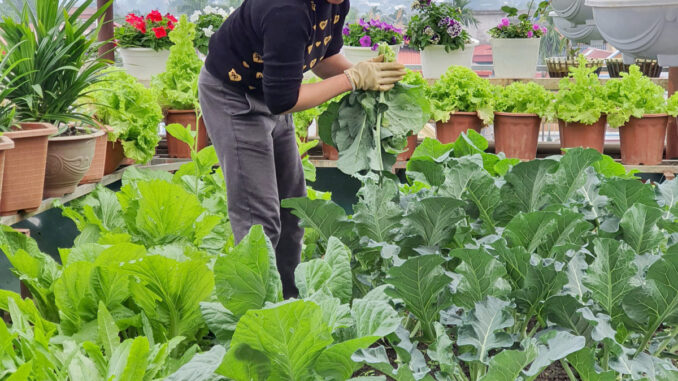
YEN BAI – Sister Phuong Mai in Nghia Lo town divides beds and builds drainage ditches to turn the garden like a field on the third-floor terrace.

When she built a house in 2009, she designed her own rooftop garden. At that time, the rooftop vegetable growing movement was not really popular, so she could not learn from anyone but tinker with it herself.
“The motivation for me to do vegetable gardening is my small children. I want my children to eat clean vegetables and fruits, not buy anything, worry about what they eat,” the mother of four shared.

The terrace area is 170 m2, in which she built a swimming pool for the children, a tea table, 70 m2 for growing vegetables, and 12 m2 for a chicken coop.
Particularly, the garden soil is very well waterproofed. A week after pouring the roof, she mixed it with cement and soaked it in water for two months. After polishing, she spread the canvas and began to build the beds.

The whole garden has 9 beds, each bed is 1.1 meters wide and 4.5 meters long. The width of the beds is calculated to fit three plants of cabbage, beans, cauliflower or four kohlrabi, five cabbage…
Instead of buying land, Ms. Mai uses indigenous hilly land and improves it with hunched rice husks and chicken manure. The soil improvement process takes six months before sowing.

Along the beds are drainage ditches, avoiding waterlogging for the garden.
Although investing and gardening methodically, the first time planting is not easy. The biggest difficulty is the deep cold and frost in the Northwest winter, causing the vegetable beds to die after a cold spell. The soil is infertile, the trees are inert after just one night of summer rain. The garden is also always wet, with many pests and diseases. “A lot of times, I just improved the fertile soil bed, the new tree was planted, then after a night of rain, it was successful,” she said.

In 2016, Ms. Mai decided to make more transparent plastic roofs to cover rain, sun, dew, and wind. “Since then, gardening has become much simpler and almost anything growing vegetables and fruits will be abundant,” said Mai.

Currently, the garden is filled with cabbage, kohlrabi, cauliflower, cabbage, beans, and tomatoes.
She has just harvested dozens of cabbages, weighing 12 kg, to make kimchi. The cabbages were collected after only 2.5 months, white and stocky, making everyone’s eyes pleasing to the eye.

Applying the garden-barn model, she uses old vegetables and vegetables that can’t be eaten all to raise chickens. In contrast, use composted chicken manure with rice husks to fertilize the garden. Currently, the barn is regularly maintained for 30 laying hens, with an average of 7 to 12 eggs per day.

Over the years, there have been many times in the area where vegetables are scarce due to the weather, or when the epidemic is limited to buying food, Mai’s family is still active. “When there is a shortage of vegetables, I have vegetables and eggs to give away, everyone is very precious,” she said.

Although her family currently has a rose, vegetable and hill chicken farm near her house, Mai still devotes a lot of enthusiasm to the terrace garden, because, for her, it is an indispensable part of life. After a busy day with her business, she still tries to spend at least an hour in the garden.
“This place not only provides my family with green, clean and fresh vegetables every day but also a place for me to regain my balance after a stressful day. Just going to the garden makes me tired,” she said.
Follow(vnexpress)
